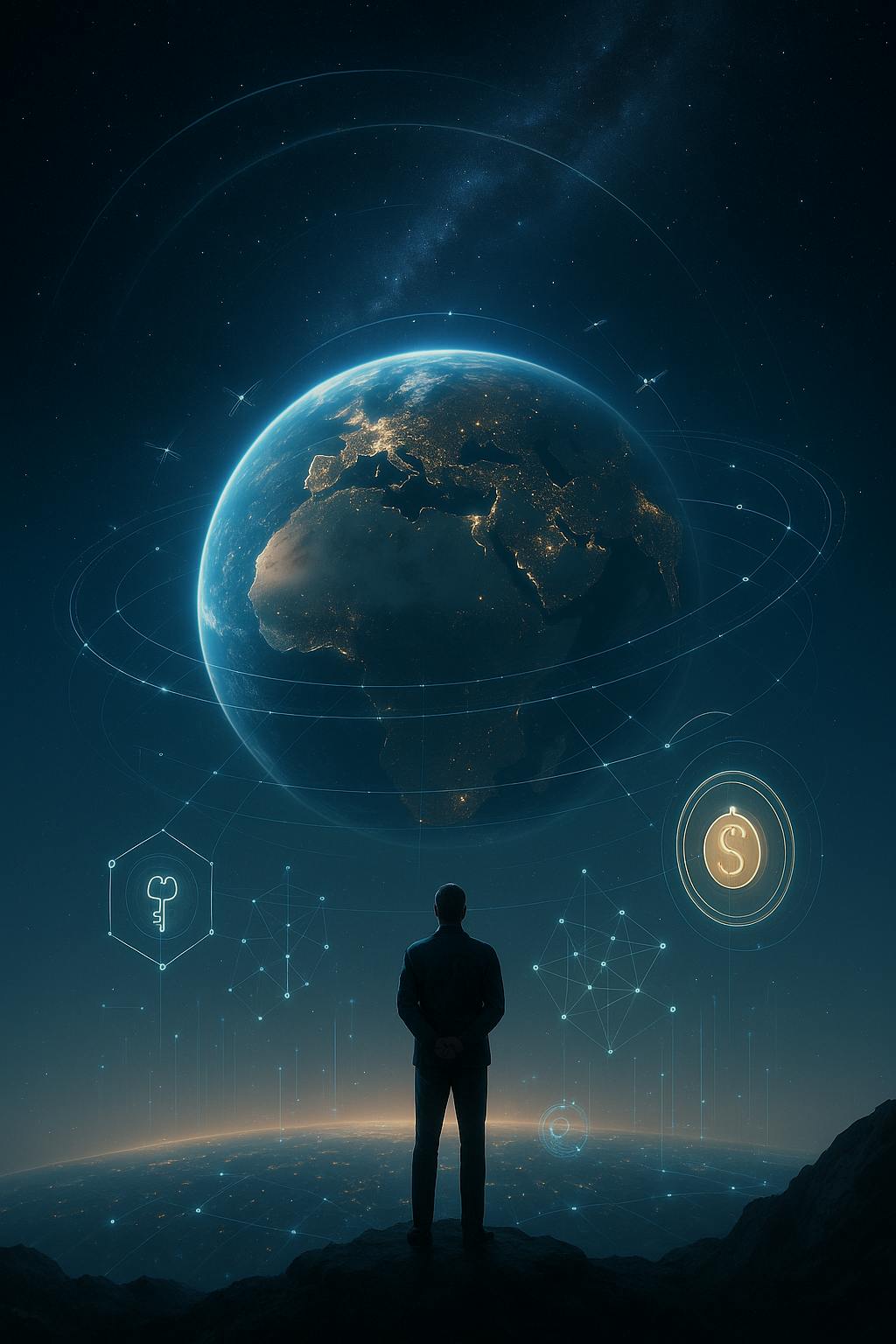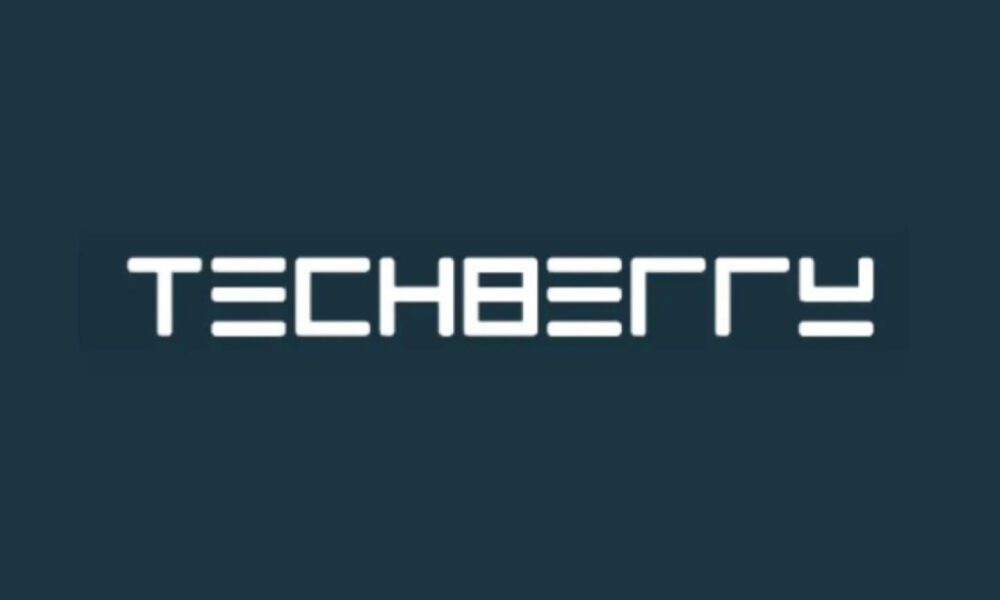In 1964, Soviet astronomer Nikolai Kardashev suggested a way to measure how advanced a civilization is by looking at its energy use. A Type-1 civilization uses all the energy available on its planet, about 10^16 watts. While Kardashev focused on energy, today we see that controlling information is just as important for progress. As we get closer to working together on a global scale, our digital systems are still divided, weak, and stuck on Earth. SpaceCoin’s satellite-based decentralized network could help solve this gap between what we can do with technology and the limits of our infrastructure.
The Kardashev Scale and Information Mastery
The Kardashev scale is used to rank alien civilizations and helps us see where humanity stands. A Type-1 civilization uses energy on a global scale. We are currently around 0.73 on this scale and might reach Type-1 in 100-200 years if technology keeps advancing. Progress needs not just energy but also a global information network, including communication and data systems.
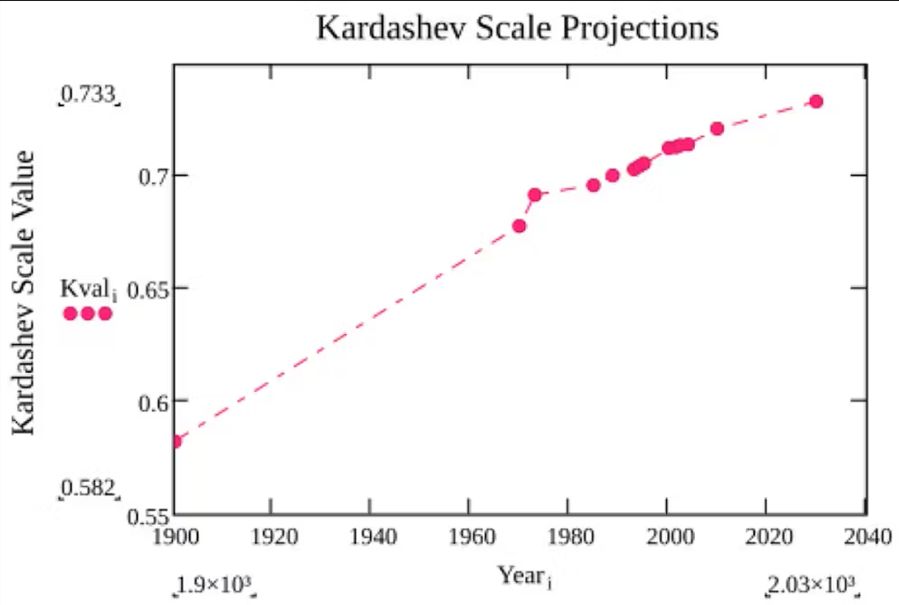
Today’s internet setup doesn’t meet these needs. As of 2024, about 2.6 billion people, or one-third of the world’s population, still don’t have internet access, according to the International Telecommunication Union. Even for those who are connected, access is controlled by central service providers, which can be affected by outages, censorship, and political issues. The current internet was built for a world of countries and big companies, not for a global civilization.
The Missing Layer: Earth-Bound, Fragile, and Censorable Networks
The current internet setup has three major weaknesses that hold back our progress:
Geographic Fragmentation: Internet infrastructure relies on physical cables, cell towers, and data centers mostly found in wealthy areas. Many parts of Africa, South Asia, and Latin America don’t have reliable internet access. This inequality leads to information gaps that worsen economic and social differences. Remote areas, seas, and places hit by disasters often lose all communication.
Centralized Control: A few companies and governments control most of the internet infrastructure. In the U.S., Amazon Web Services, Google Cloud, and Microsoft Azure host most cloud services. Google handles over 90% of search traffic, while Facebook, Instagram, YouTube, and TikTok dominate social media. This concentration creates weak spots and allows for large-scale censorship.
Vulnerability to Disruption: Land-based networks can be affected by natural disasters, attacks on infrastructure, and political actions. Recent events have shown this weakness: cuts to submarine cables can disrupt whole regions, cyberattacks can hit important infrastructure, and governments often slow down or block internet access during political unrest. The 2024 global internet outages impacted millions of users across many continents, showing the risks of centralized infrastructure.
These weaknesses are not just technical issues; they limit our ability to work together globally. A Type-1 civilization cannot operate with an information system that leaves out a third of the population, is controlled by a few entities, and fails when communication is most needed.
Spacecoin’s Role: Expanding Digital Sovereignty to Orbit
Spacecoin’s satellite-based blockchain network enhances security, reliability, and efficiency with three innovations. It uses a decentralized satellite network to securely transmit data, reducing interception risks and ensuring continuous operation. Advanced encryption protects data from cyber threats, keeping transactions secure. The network’s consensus mechanism is optimized for satellite communication, handling latency and bandwidth challenges to ensure fast and accurate transactions. This makes Spacecoin’s network a reliable and efficient platform for secure global transactions.
Orbital Infrastructure: By deploying low-Earth orbit (LEO) satellites, Spacecoin creates a communication infrastructure independent of terrestrial geography. The CTC-0 satellite, launched in December 2024, demonstrated space-based blockchain transactions, transmitting encrypted data from Chile to Portugal. This shows satellites can act as decentralized network nodes, providing connectivity to underserved regions.
The orbital approach offers advantages like coverage to remote areas and resilience during disruptions. The planned CTC-1 constellation, set for Q4 2025, will expand coverage and show inter-satellite communication capabilities.
Decentralized Architecture: Spacecoin uses the Creditcoin blockchain to eliminate centralized control. Participants can join by deploying satellites that follow open standards, creating a distributed system free from single-entity control. This setup resists censorship, making it hard for governments or corporations to block or monitor communications. The economic model encourages network growth, with satellite operators earning tokens based on usage, promoting market-driven deployment. For example, a Nigerian telecom company could launch satellites for Nigeria but earn globally as they provide services elsewhere, turning satellites into global infrastructure.
Redundancy Across Space and Earth: Spacecoin enhances terrestrial internet with orbital redundancy. Users can choose between terrestrial or satellite networks based on availability, cost, and security. This hybrid system ensures resilience; if one fails, the other remains operational.
The system uses store-and-forward networking, where satellites handle data with a delay-tolerant architecture, ensuring data integrity through cryptographic verification. The Chile-to-Portugal transmission showed blockchain transactions can maintain integrity via orbital relay, proving technical feasibility for complex applications.
From Gutenberg to Spacecoin
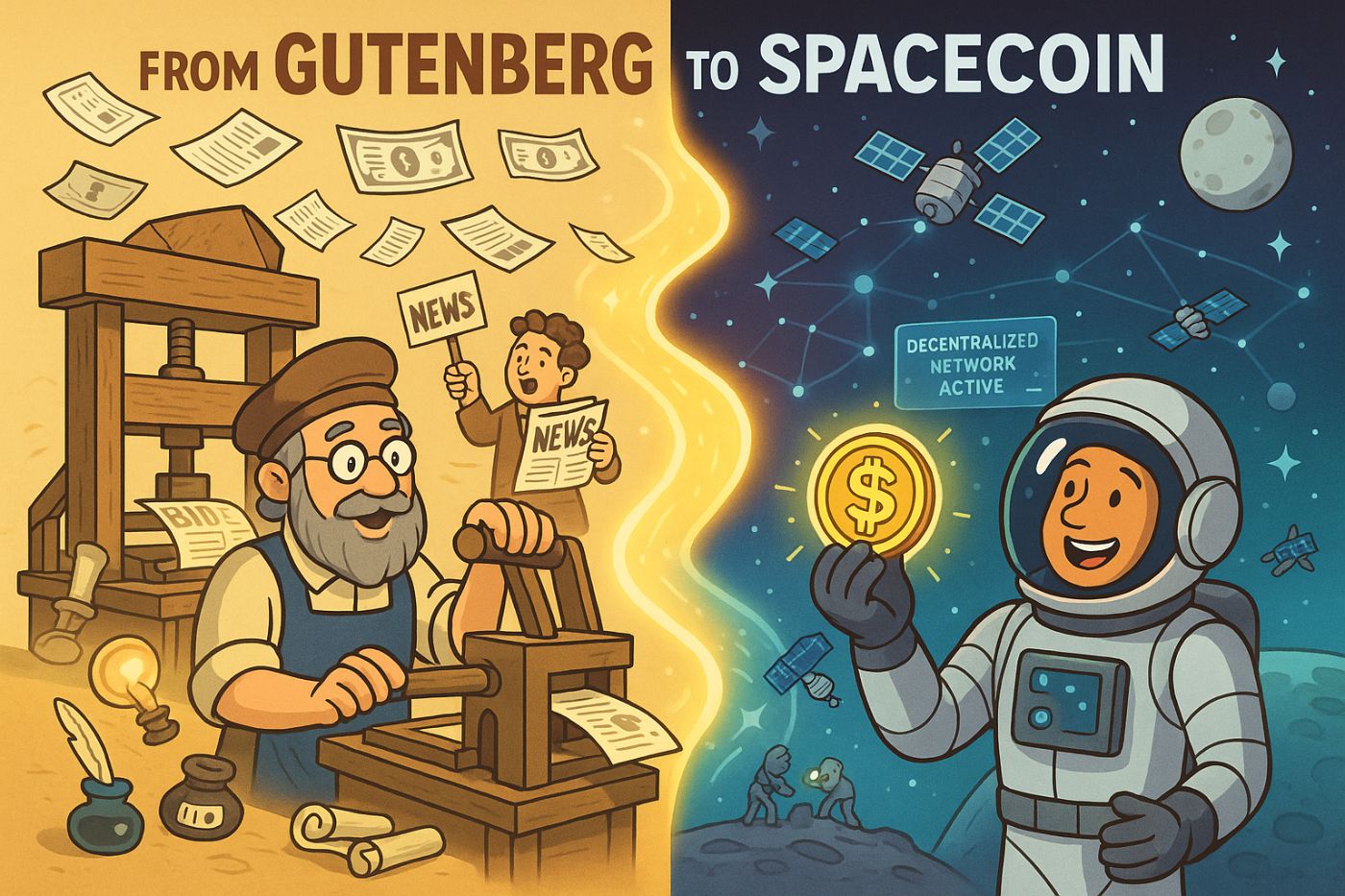
The printing press, created by Johannes Gutenberg around 1450, changed how people accessed knowledge. Before this, information was hard to find and controlled by a few, with books being rare and costly. Gutenberg’s press made books cheaper, increasing literacy and leading to big social changes like the Reformation and the Enlightenment.
Spacecoin might have a similar effect by breaking up digital communication monopolies, allowing people to access information and participate in decision-making. History shows this pattern: the telegraph enabled real-time long-distance communication, radio and television created mass media with centralized control, and the internet initially spread information access but later became more centralized again. Each change improved human coordination and brought new governance challenges.
Infrastructure for Humanity’s Collective Memory
Orbital infrastructure not only improves communication but also reduces risks like global disasters. Earth faces dangers like asteroid impacts, nuclear war, and climate change. A disaster could wipe out data centers and communication networks, losing much of humanity’s knowledge.
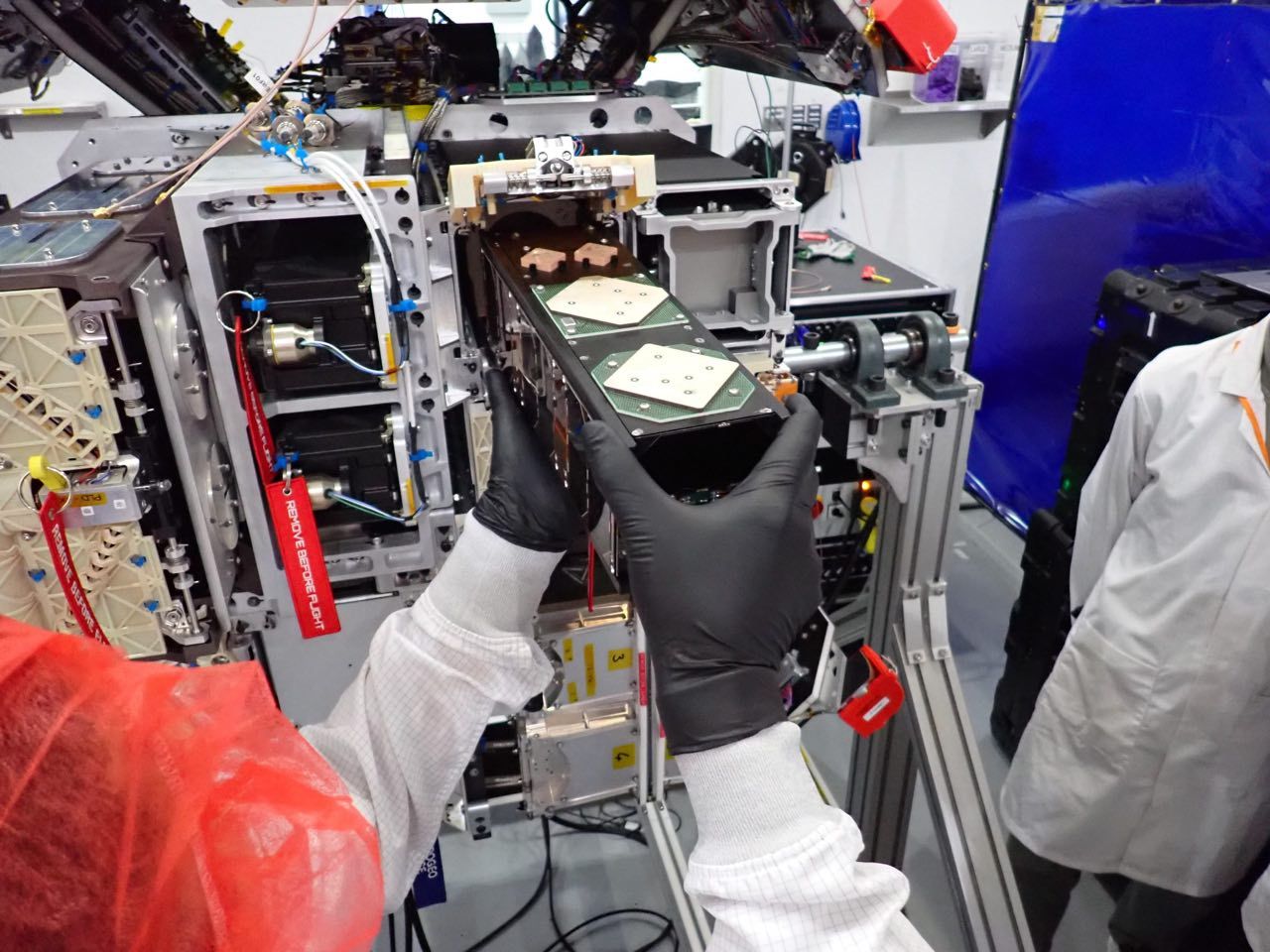
Satellites provide backup by keeping important information and communication going even if ground systems fail, making us more resilient. This supports Stephen Hawking’s idea of becoming multi-planetary. Spacecoin focuses on communication, aiming for infrastructure that doesn’t depend only on Earth, reducing single points of failure. Orbital infrastructure helps with global coordination for issues like climate change and pandemics. Networks that resist censorship ensure information sharing for collective action, offering vital alternatives when governments limit information during crises.
A Decentralized Web That Outlasts the Planet
Human technology impacts global systems, but our information systems are weak and scattered, making it hard to solve global problems. Spacecoin’s satellite network offers a solution by providing decentralized, strong communication beyond Earth. This could help global cooperation for a Type-1 civilization. The change will face technical, legal, and competitive challenges, but a strong information system is key to using planetary energy.
Whether Spacecoin succeeds is less important than the direction it points to. Humanity’s move toward Type-1 status relies not only on energy technology but also on information systems that connect everyone, resist censorship and disruption, and keep knowledge safe from planetary risks. Orbital decentralized networks offer a path to that future—a Type-1 internet for a Type-1 civilization, a system that could last beyond the planet itself.

